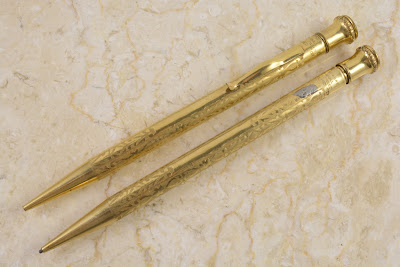This article has been edited and included in The Leadhead's Pencil Blog Volume 5; copies are available print on demand through Amazon here, and I offer an ebook version in pdf format at the Legendary Lead Company here.
If you don't want the book but you enjoy this article, please consider supporting the Blog project here.
Nowhere is that more true than when it comes to two manufacturers I’ve been researching for years: the DeWitt-LaFrance Company of Boston, best known as the maker of the Superite, and the Rex Manufacturing Company of Providence, Rhode Island. Both of these companies had a profound influence on the American pencil industry during the late teens and the twenties ... and both were almost completely forgotten.
How two such prominent manufacturers could simply vanish has fascinated me to the point of obsession – you can’t do an online search on either of these two companies without running into a slew of posts here, and not much else. Joe Nemecek has often joked with me that by the time I’m done researching things, I will have concluded that everything was manufactured by either one or the other.
With that bit of background, imagine if my research led me to a connection between the two . . .
When this pencil surfaced in an online auction recently, it set off an alarm somewhere deep in my mind that even with a missing clip, this was a key piece of a much larger puzzle. It led me to retrace my steps and, with the benefit of a couple years’ worth of hindsight, to see things a bit more clearly.
The research I did involved the metal Eclipse “Never-Dull” pencils, beginning with a 2013 article titled “Never a Dull Moment” (http://leadheadpencils.blogspot.com/2013/06/never-dull-moment.html). I noted three variations of the Eclipse Never-Dull: one with a clip similar to that found on a Morrison, one sporting a patented DeWitt-LaFrance clip, and one identical to a sterling “Rexhold” Never-Dull. I later confirmed “Rexhold” was a Rex Manufacturing Company trademark (http://leadheadpencils.blogspot.com/2015/05/a-definitive-answer-and-more-distinct.html).
And, at the end of the article, I noted that there was another brand marketed as a “Never-Dull”: the Albert Howard, which I had conclusively identified as having been made by DeWitt-LaFrance based on the distinctive pattern found on the barrel:
At the time the article ran, all I had was a picture of an Albert Howard owned by Sue Hershey. Some time later, I prevailed upon Sue to part with the pencil, and at the DC Show Rick Krantz had a full-sized version in his junk box.
I didn’t think either of these developments were noteworthy enough for an article; there were no new revelations to be had from Sue’s pencil once I had it in hand, and Rick’s example wasn’t in the best shape, with kind of a boring imprint:
So three years ago, these slipped quietly into my collection and I had not thought of them since . . . until this new Albert Howard came along and got me to thinking about these with fresh eyes.
This recent acquisition is identical to an Eclipse Never-Dull, with the same pattern as found on the Rexhold Never-Dull:
Which leads me back to Rick’s example; I wondered whether it fit into the Rex-made pile like this one, or into the DeWitt-LaFrance pile, along with the other Albert Howard. When I looked at it, I saw something that I had not noticed before:
It has alternating panels of that same floral brocading and a three-row checkerboard pattern identical to the pattern on another of my Eclipse Never-Dull pencils:
But it’s which one of them that is fascinating:
This Albert Howard is the perfect love child of the clearly Rex-made Eclipse and the equally clearly DeWitt-LaFrance-made Eclipse.










No comments:
Post a Comment